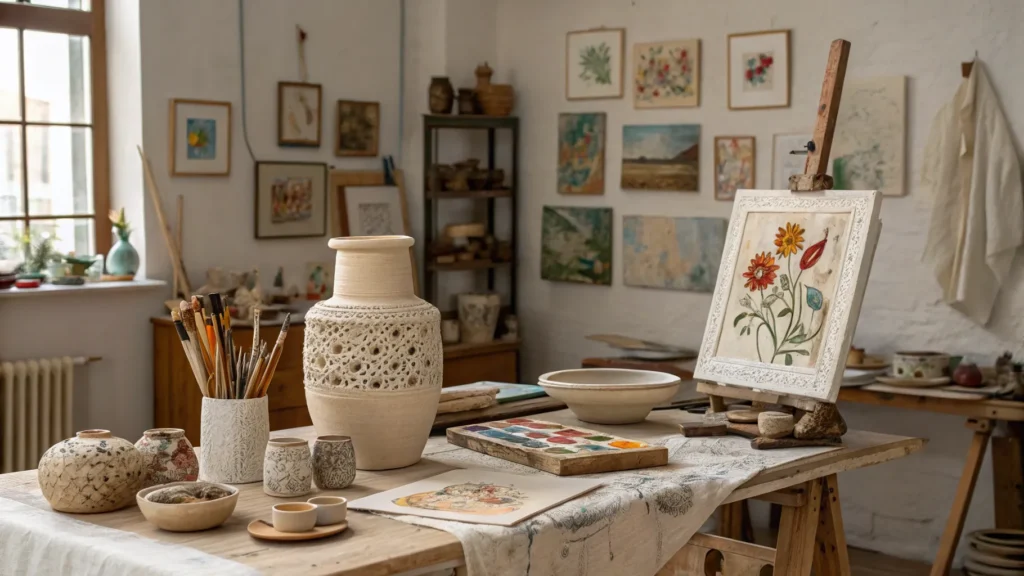
Artists who merge advantageous artwork with craft traditions are rising quick, and the market is taking discover. That was the clear sign from Rebekah Bowling, who stated the motion is gaining traction now. The shift is seen in galleries, gala’s, and studios, the place ceramics, textiles, wooden, and glass seem beside portray and sculpture. Collectors are asking new questions on supplies, labor, and worth, pushing this hybrid strategy to heart stage.
Bowling’s remark captures a wider change. Makers with coaching in craft fields are getting into the advantageous artwork market. Painters and sculptors are additionally choosing up looms, kilns, and hand instruments. The result’s a wave of labor that’s tactile, traditionally rooted, and pointed at present social themes. It is usually increasing what counts as “critical” artwork.
A Easy Assertion With Huge Penalties
“Artists mixing advantageous artwork and craft are having a second.” — Rebekah Bowling
Her view displays a broader urge for food for material-driven work. The urge for food spans worth factors, from rising makers to mid-career artists. It additionally cuts throughout kinds, from rough-hewn clay types to intricate textiles. Sellers say the enchantment lies in two issues: seen ability and human contact.
Artists are utilizing conventional processes to talk to present points. Many hyperlink fiber and clay to themes of care, home area, and labor. Others use the handmade floor to discover identification and heritage. The combo can really feel new to consumers who got here of age on screen-based artwork, but it attracts on lengthy histories in craft communities.
Background: From Margins to Market
For many years, establishments positioned craft in a separate lane. That line has blurred. Museum exhibits, tutorial packages, and residencies have opened doorways to interdisciplinary work. Public sale catalogs now combine ceramics and textiles with portray. Artwork gala’s add sections for material-focused practices.
The shift tracks with a broader rethinking of who will get included within the artwork story. Many craft traditions come from communities that have been missed. As establishments reassess their collections, they give the impression of being tougher at fiber, clay, and metalwork. Youthful audiences, raised on making and DIY tradition, are additionally fast to reply.
Market Indicators and Studio Observe
Sellers report waitlists for artists who innovate with clay, fiber, and wooden. Studio visits present longer manufacturing timelines, since many items require sluggish, exacting steps. That tempo can restrict provide however increase demand. Some artists collaborate with grasp fabricators, whereas others preserve each step in-house to protect contact and method.
- Supplies that lead the cost: clay, textiles, glass, and carved wooden.
- Themes that resonate: residence, labor, care, and cultural reminiscence.
- Patrons search for seen course of, sturdiness, and provenance.
The house design sector has additionally influenced style. Collectors snug investing in crafted furnishings and lighting now purchase sculptural ceramics and woven wall works. The boundary between design object and art work stays debated, however that debate fuels curiosity relatively than dampening it.
Establishments, Fairness, and Schooling
Museums and colleges play a task on this momentum. Expanded packages in ceramics and fiber draw new college students. Curators pair craft-based works with work and movies, exhibiting how concepts journey throughout mediums. Grants and prizes help materials analysis and conventional strategies.
This shift additionally invitations a wider set of makers. Communities with deep craft lineages see new recognition. When establishments current these practices alongside canonical works, they rewrite the narrative. That change carries weight for future scholarship and funding.
Skepticism and Sustainability
There are cautions. Some worry a pattern cycle that might cool as rapidly because it rose. Others fear that demand for intricate items might push artists into repetitive manufacturing. Normal issues about sturdiness, conservation, and show additionally floor, particularly for textiles and natural supplies.
Market stability could depend upon schooling. Collectors who perceive course of and care necessities make higher long-term selections. Clear documentation and conservation steering assist museums and personal homeowners shield works over time.
What Comes Subsequent
If the momentum holds, count on deeper collaboration throughout mediums. Painters may fit with weavers. Sculptors could companion with glass studios. Digital instruments might map patterns or types which might be then realized by hand. The hand will stay central, however the toolkit will develop.
Bowling’s commentary captures a key flip in style and values. The handmade floor, as soon as sidelined, has moved into the highlight. For artists, meaning extra paths to indicate and promote their work. For collectors and establishments, it means rethinking classes and care.
The subsequent yr will take a look at how sturdy this shift is. Watch museum acquisitions, honest shows, and faculty enrollments. If these indicators rise collectively, the combo of advantageous artwork and craft won’t simply have a second. It’ll have endurance.

